The Entomology Program conducts plant pest surveys (insects, plant diseases, and nematodes). Plant pest surveys can be conducted by periodic visual surveys, sampling, or regular detection trapping programs. Surveys are conducted to determine if a particular pest exists in an area (example, in a county), and if found, how extensive the infestation is. Surveys are also needed to determine the feasibility of eradication, areas where eradication treatments need to be applied, and areas where quarantine measures need to be applied.
Plant pest survey data is needed in order to facilitate exports. Presence or absence data is important. Plant pests that may hinder or restrict plant and plant product exports should be surveyed. Laboratory diagnosis of the plant pests is crucial. This data is needed to document pest-free areas. Pest management areas will also be gained from survey data. Coordination of a statewide survey is important to the plant industry of Nebraska.
Regionalization provides for the certification of plants and plant products on a regional basis. This regional approach allows for the establishment of pest-free areas.
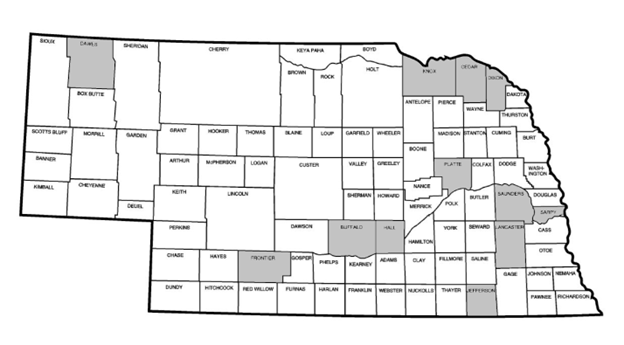 In 2024, NDA continued a survey for agricultural pests that have the potential to cause damage to Nebraska’s crops if they are introduced to our state. NDA set and monitored traps at 16 sites in 12 counties across Nebraska. Survey pests included old world bollworm (Helicoverpa armigra), silver Y moth (Autographa gamma), and golden twin-spot moth (Chrysodeixis chalcites). Each site consisted of three bucket traps. All traps were confirmed negative.
In 2024, NDA continued a survey for agricultural pests that have the potential to cause damage to Nebraska’s crops if they are introduced to our state. NDA set and monitored traps at 16 sites in 12 counties across Nebraska. Survey pests included old world bollworm (Helicoverpa armigra), silver Y moth (Autographa gamma), and golden twin-spot moth (Chrysodeixis chalcites). Each site consisted of three bucket traps. All traps were confirmed negative.
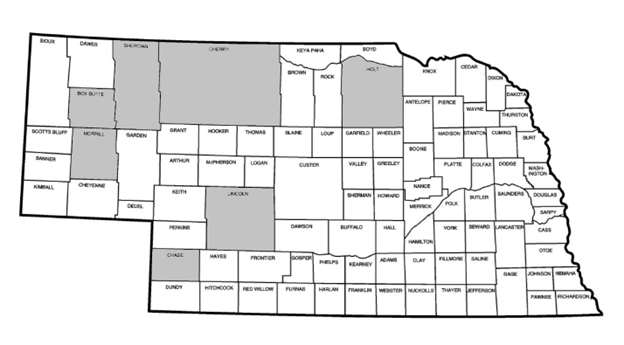 Field locations for seed potatoes, tablestock potatoes, and nursery growers who export were sampled from September through November 2024. A total of 26 soil samples were taken from 7 counties across Nebraska. Samples were submitted for analysis to the UNL Plant Pathology Department for the presence of quarantine and export significant nematodes including: potato rot (Ditylenchus destructor); potato cyst (Globodera pallida, G. rostochiensis); soybean cyst nematode (Heterodera glycines); root knot nematodes (Meloidogyne chitwoodi, M. hapla, M. javanica); and other plant parasitic nematode genera. Dr. Tom Powers, UNL nematologist, and his staff conduct morphological and molecular diagnostics of all adult and juvenile nematodes found in the soil samples. The identification of plant parasitic nematodes helps to establish and maintain pest-free areas for the export of plants and plant products. All samples were negative for quarantine pests.
Field locations for seed potatoes, tablestock potatoes, and nursery growers who export were sampled from September through November 2024. A total of 26 soil samples were taken from 7 counties across Nebraska. Samples were submitted for analysis to the UNL Plant Pathology Department for the presence of quarantine and export significant nematodes including: potato rot (Ditylenchus destructor); potato cyst (Globodera pallida, G. rostochiensis); soybean cyst nematode (Heterodera glycines); root knot nematodes (Meloidogyne chitwoodi, M. hapla, M. javanica); and other plant parasitic nematode genera. Dr. Tom Powers, UNL nematologist, and his staff conduct morphological and molecular diagnostics of all adult and juvenile nematodes found in the soil samples. The identification of plant parasitic nematodes helps to establish and maintain pest-free areas for the export of plants and plant products. All samples were negative for quarantine pests.
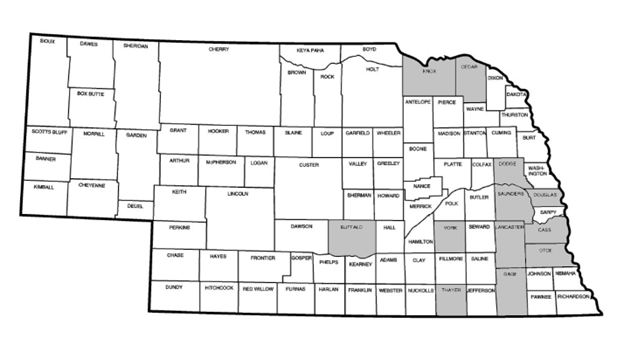 From July-December 2024, NDA conducted 27 visual surveys in 12 counties across Nebraska for presence of ALB. Visual surveys were conducted to determine the presence of ALB at nurseries, campgrounds, state parks, wood recyclers, and other public lands across the state. Asian longhorned beetle was not detected at any location surveyed this year.
From July-December 2024, NDA conducted 27 visual surveys in 12 counties across Nebraska for presence of ALB. Visual surveys were conducted to determine the presence of ALB at nurseries, campgrounds, state parks, wood recyclers, and other public lands across the state. Asian longhorned beetle was not detected at any location surveyed this year.
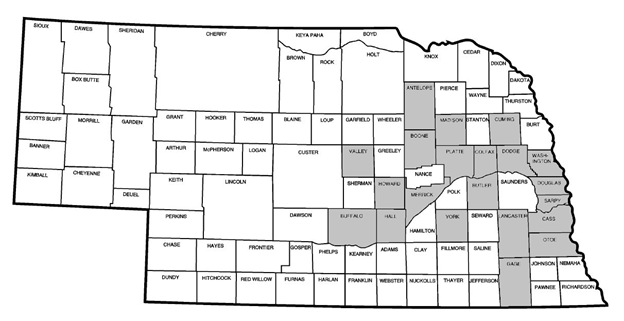 During the 2024 season, NDA inspected 67 Christmas tree dealer locations in 21 counties across the state. Inspections occurred in November and December to verify compliance with the federal Spongy Moth and Sudden Oak Death quarantines. Inspectors confirm compliance through paperwork review and physical inspection of the trees to help prevent the introduction of plant pests. Three Withdrawal-From-Distribution Orders were issued in 2024.
During the 2024 season, NDA inspected 67 Christmas tree dealer locations in 21 counties across the state. Inspections occurred in November and December to verify compliance with the federal Spongy Moth and Sudden Oak Death quarantines. Inspectors confirm compliance through paperwork review and physical inspection of the trees to help prevent the introduction of plant pests. Three Withdrawal-From-Distribution Orders were issued in 2024.
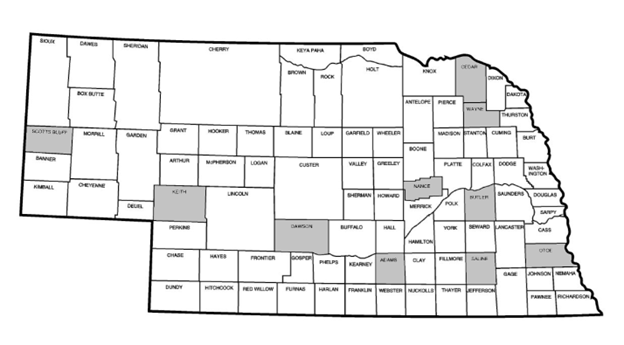 During the 2024 season, NDA set and monitored 30 traps in 10 counties at high-risk areas, such as state parks and rest areas.
During the 2024 season, NDA set and monitored 30 traps in 10 counties at high-risk areas, such as state parks and rest areas.
The USDA officially deregulated EAB and has lifted the federal quarantine in 2021. NDA has no plans to enact a state quarantine for EAB but has continued to inspect nursery stock for insect and disease problems, including EAB. NDA will continue to work to educate the nursery industry about this potential threat to ash trees in Nebraska, through outreach programs. NDA has developed EAB outreach materials, which continue to be distributed at various industry meetings and conferences, and are also available on the NDA web site.
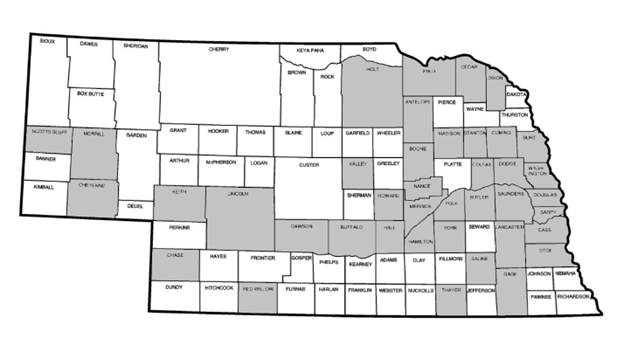 NDA inspectors inspect firewood dealers across the state to confirm compliance with state and federal quarantines that regulate the movement of firewood. A total of 92 firewood dealers in 40 counties were inspected to verify compliance with federal Spongy Moth quarantine, Asian Longhorned Beetle quarantine, and the Nebraska Thousand Cankers Disease of Walnut quarantine. While some of the wood was of Nebraska origin, wood was also found to have originated in other states, including Colorado, Illinois, Iowa, Michigan, Tennessee, and Wisconsin. Four withdrawal-From-Distribution Orders were issued in 2024. However, these orders were lifted after origins of the firewood in question were confirmed with the firewood broker and USDA.
NDA inspectors inspect firewood dealers across the state to confirm compliance with state and federal quarantines that regulate the movement of firewood. A total of 92 firewood dealers in 40 counties were inspected to verify compliance with federal Spongy Moth quarantine, Asian Longhorned Beetle quarantine, and the Nebraska Thousand Cankers Disease of Walnut quarantine. While some of the wood was of Nebraska origin, wood was also found to have originated in other states, including Colorado, Illinois, Iowa, Michigan, Tennessee, and Wisconsin. Four withdrawal-From-Distribution Orders were issued in 2024. However, these orders were lifted after origins of the firewood in question were confirmed with the firewood broker and USDA.
Outreach is also part of this effort. For more information, please see the Education and Outreach Events section.
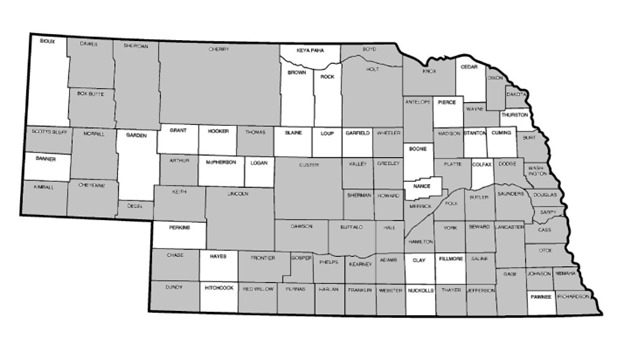 A total of 751 spongy moth (formerly gypsy moth) traps were set in 2024. Traps were set in 65 counties across the state. One trap in Washington county and one trap in Jefferson county were positive in 2023. Delimiting surveys were conducted in these areas in 2024 to determine if these areas were not infested, and that only individual male spongy moths were found in those instances.
A total of 751 spongy moth (formerly gypsy moth) traps were set in 2024. Traps were set in 65 counties across the state. One trap in Washington county and one trap in Jefferson county were positive in 2023. Delimiting surveys were conducted in these areas in 2024 to determine if these areas were not infested, and that only individual male spongy moths were found in those instances.
In 2025, delimiting surveys for positive finds will take place in Sarpy, Jefferson, and Washington counties. These surveys will help NDA determine the status of spongy moth in Nebraska.
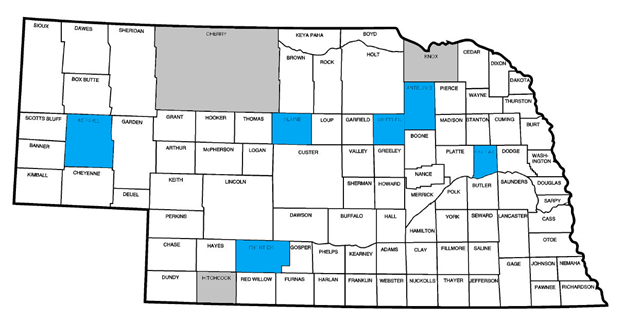 In 2024, a total of 33 JB traps (27 detection and 6 certification traps) were set in 9 counties across the state. Traps are located at airports, state parks, special quarantine compliance areas, and nurseries. Nursery stock distributors in non-infested counties that import balled and burlapped nursery stock are considered high-risk sites and, therefore, trapped individually. The traps were in place April-November 2023. A total of 9 traps were positive, in 6 counties.
In 2024, a total of 33 JB traps (27 detection and 6 certification traps) were set in 9 counties across the state. Traps are located at airports, state parks, special quarantine compliance areas, and nurseries. Nursery stock distributors in non-infested counties that import balled and burlapped nursery stock are considered high-risk sites and, therefore, trapped individually. The traps were in place April-November 2023. A total of 9 traps were positive, in 6 counties.
In 2021 Nebraska moved to Category 3 status under the Japanese Beetle Harmonization Plan. This change elevated Nebraska’s status from Category 2, partially infested, to wholly infested.
NDA continues to track the spread of Japanese Beetle in Nebraska. Antelope, Blaine, Frontier, Morrill, and Wheeler counties are now considered infested based on the results of 2023 survey. Colfax county was previously categorized as an infested county, and positive certification traps further confirmed this classification.
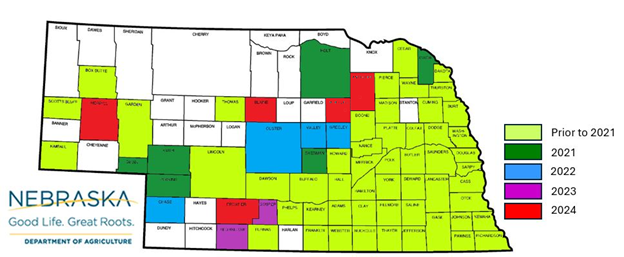
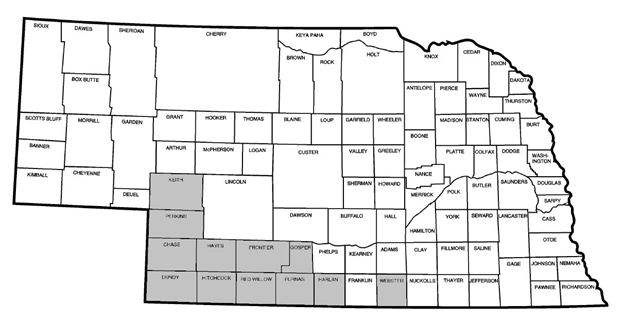 Karnal Bunt sampling occurred in July 2024. A total of 24, four-pound wheat samples were pulled in 12 counties, based on the 2024 National Karnal Bunt Survey Protocol. All samples were sent to the National Karnal Bunt Lab in Phoenix, Arizona, for analysis. NDA is currently waiting on the results of Karnal Bunt presence testing.
Karnal Bunt sampling occurred in July 2024. A total of 24, four-pound wheat samples were pulled in 12 counties, based on the 2024 National Karnal Bunt Survey Protocol. All samples were sent to the National Karnal Bunt Lab in Phoenix, Arizona, for analysis. NDA is currently waiting on the results of Karnal Bunt presence testing.
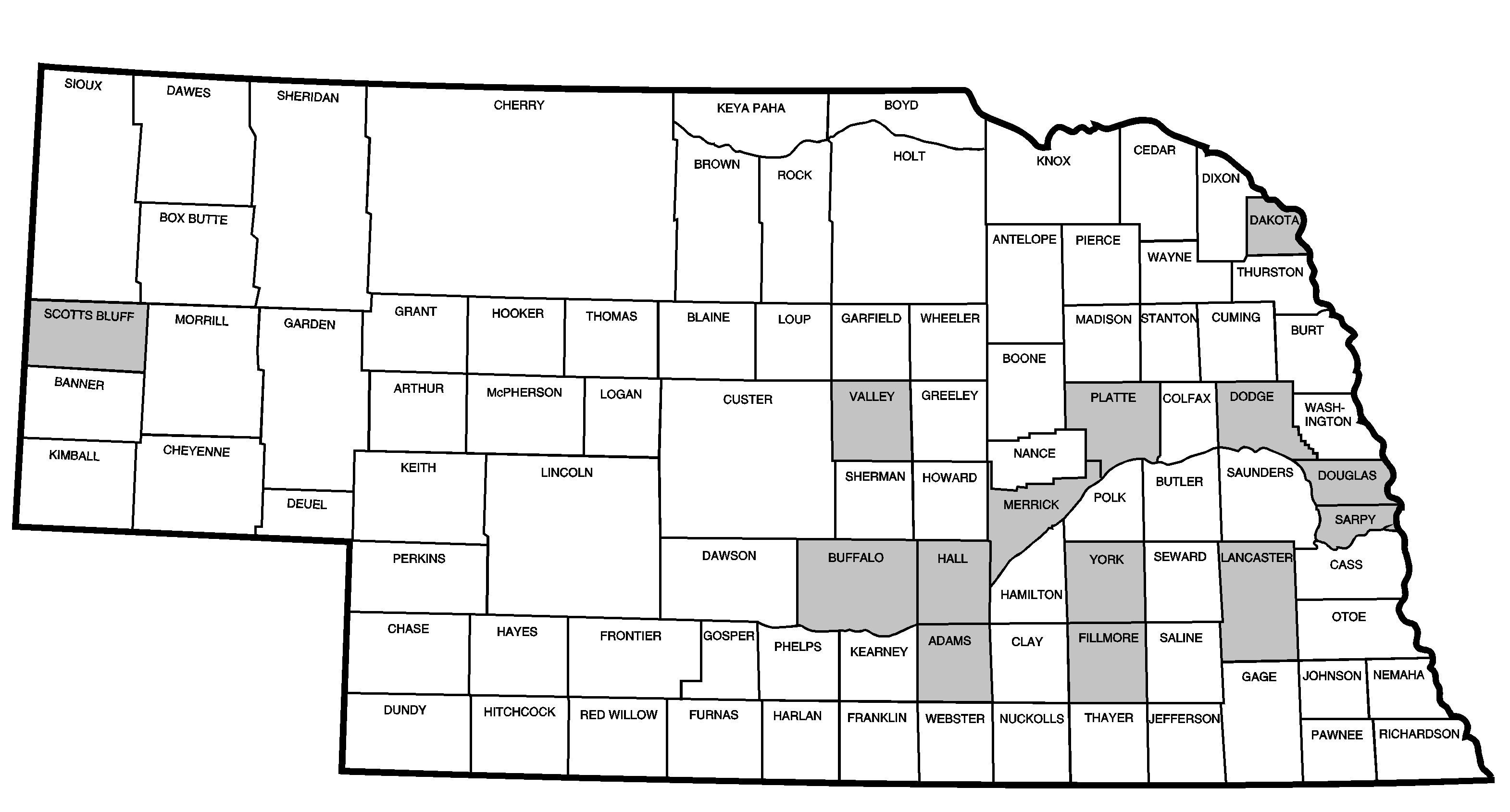 Khapra beetles are the world’s most destructive pest of grain products and seeds. While this pest is not known to be established in the U.S., the Nebraska Department of Agriculture (NDA) and the U.S. Department of Agriculture survey high-risk areas annually for Khapra beetles. Federal funding was approved for a Khapra beetle survey in Nebraska beginning in January 2024. NDA teammates set 117 traps in 15 counties in Nebraska. Traps were monitored monthly, for 90 days in the winter with surveys concluding by the end of April 2024. All traps were negative.
Khapra beetles are the world’s most destructive pest of grain products and seeds. While this pest is not known to be established in the U.S., the Nebraska Department of Agriculture (NDA) and the U.S. Department of Agriculture survey high-risk areas annually for Khapra beetles. Federal funding was approved for a Khapra beetle survey in Nebraska beginning in January 2024. NDA teammates set 117 traps in 15 counties in Nebraska. Traps were monitored monthly, for 90 days in the winter with surveys concluding by the end of April 2024. All traps were negative.
Federal funding was approved to continue the Khapra beetle survey beginning in January 2025. This January, NDA teammates set 120 traps in 24 counties in Nebraska (Boone, Box Butte, Cheyenne, Colfax, Dawes, Dodge, Douglas, Fillmore, Gage, Hall, Hamilton, Lancaster, Lincoln, Madison, Merrick, Morrill, Nuckolls, Otoe, Platte, Saline, Sarpy, Scotts Bluff, Valley, and York counties). Traps are monitored monthly for 90 days with surveys concluding by the end of April 2025.
 NDA participated in the National PCN survey from October through November 2024. 2,387 – 5-pound soil samples were collected, from 7 counties. Samples were sent to the USDA Idaho Falls PCN laboratory for processing to determine the presence or absence of Pale and Golden Cyst Nematodes (Globodera pallida and Globodera rostochiensis). Results for 2024 survey are pending.
NDA participated in the National PCN survey from October through November 2024. 2,387 – 5-pound soil samples were collected, from 7 counties. Samples were sent to the USDA Idaho Falls PCN laboratory for processing to determine the presence or absence of Pale and Golden Cyst Nematodes (Globodera pallida and Globodera rostochiensis). Results for 2024 survey are pending.
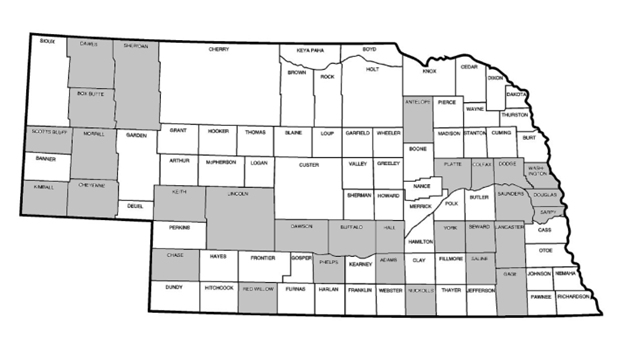 During early spring of 2024, NDA inspectors conducted compliance inspections at 101 seed potato dealer locations in 30 counties. These inspections were to confirm compliance with Nebraska’s Columbia Root Knot Quarantine, and the Federal Potato Cyst Nematode quarantine. In 2024, NDA inspectors restricted and witnessed the destruction of seed potato packages at 15 retailers that were in violation of Nebraska’s quarantine policy.
During early spring of 2024, NDA inspectors conducted compliance inspections at 101 seed potato dealer locations in 30 counties. These inspections were to confirm compliance with Nebraska’s Columbia Root Knot Quarantine, and the Federal Potato Cyst Nematode quarantine. In 2024, NDA inspectors restricted and witnessed the destruction of seed potato packages at 15 retailers that were in violation of Nebraska’s quarantine policy.
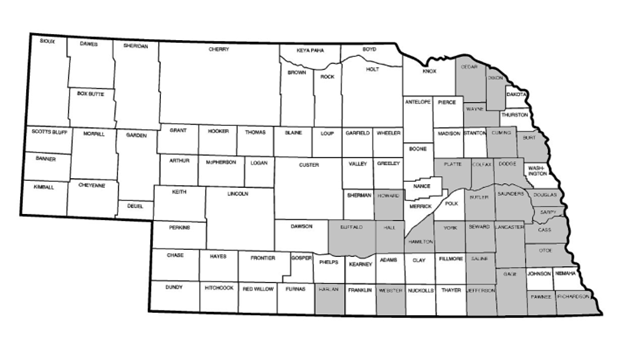 From May – December 2024, NDA conducted 77 visual surveys in 28 counties across Nebraska for SLF and Tree of Heaven (ToH), the preferred host of adult SLF. Visual surveys were conducted to determine the presence of SLF or ToH at nurseries, urban greenspaces, roadways, and forested areas across the state. These surveys will be used to record high-risk areas for introduction and establishment of SLF in Nebraska. A total of 70 of the 77 locations surveyed had ToH present. SLF was not detected at any location surveyed this year.
From May – December 2024, NDA conducted 77 visual surveys in 28 counties across Nebraska for SLF and Tree of Heaven (ToH), the preferred host of adult SLF. Visual surveys were conducted to determine the presence of SLF or ToH at nurseries, urban greenspaces, roadways, and forested areas across the state. These surveys will be used to record high-risk areas for introduction and establishment of SLF in Nebraska. A total of 70 of the 77 locations surveyed had ToH present. SLF was not detected at any location surveyed this year.
If you think you’ve found a Spotted Lanternfly, take pictures or collect a specimen, and report your suspicions to the NDA Entomology Program at 402-471-2351 or email us at agr.plant@nebraska.gov.
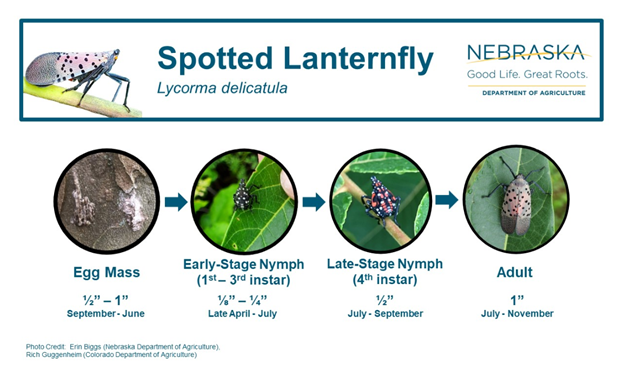
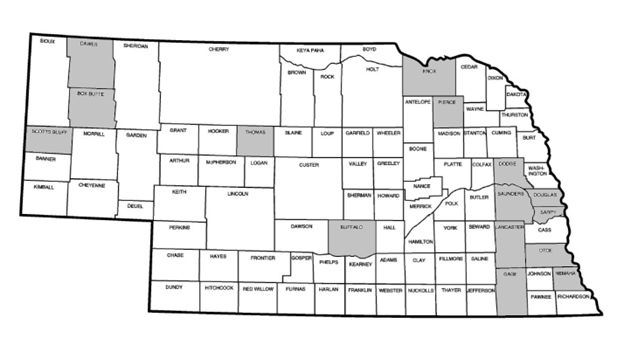 In 2024, NDA trapped for walnut twig beetle at a total of 17 sites in 15 counties. Most trapping sites consisted of three multi-funnel traps in various locations for a total of 45 traps in the state. This survey was very labor intensive. In order to maintain the viability of the sample for accurate ID of the pest, traps were serviced every two weeks. All traps were negative for walnut twig beetle in 2024. Traps set in Scotts Bluff County collected walnut twig beetles in 2019, 2020, and 2022. NDA will continue to monitor the status of this pest in the state. The causative agent of Thousand Cankers Disease, Geosmithia morbida, has not been detected in Nebraska. There is currently no quarantine or export restrictions in place for this pest, pending the detection of infected trees or firewood.
In 2024, NDA trapped for walnut twig beetle at a total of 17 sites in 15 counties. Most trapping sites consisted of three multi-funnel traps in various locations for a total of 45 traps in the state. This survey was very labor intensive. In order to maintain the viability of the sample for accurate ID of the pest, traps were serviced every two weeks. All traps were negative for walnut twig beetle in 2024. Traps set in Scotts Bluff County collected walnut twig beetles in 2019, 2020, and 2022. NDA will continue to monitor the status of this pest in the state. The causative agent of Thousand Cankers Disease, Geosmithia morbida, has not been detected in Nebraska. There is currently no quarantine or export restrictions in place for this pest, pending the detection of infected trees or firewood.